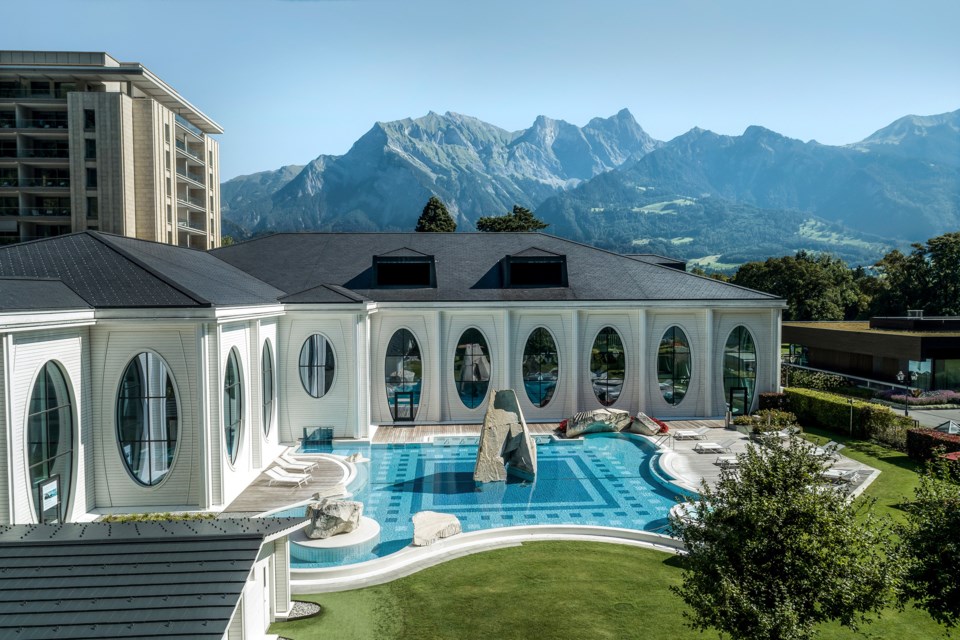On a frosty autumn in 1242, afield on a bird hunt, monks from the Benedictine abbey at Pfäfers, Switzerland, were piqued by a mist rising from a narrow gorge along the Tamina River. This being the Middle Ages, locals had long-attributed such issuances to dragon’s breath and assiduously avoided the source. But driven by their own divine imagination—or lack of birds—the curious monks made the difficult descent to discover hot springs pouring from rock adjacent to the river. In a land of ice-cold, glacier-fed cataracts, this was surely a gift from god.
Not only were the warm, lightly mineralized waters restorative to soak in, but people from near and far afflicted by a litany of ailments (again, Middle Ages) were happy to pay local entrepreneurs—who leased the springs from the business-minded abbey—for just this privilege. From here, things followed the predictable course of any miracle cure: steep prices for a limited resource.
The first cost was difficult access: those who could shimmied down ladders into the gorge; others were lowered in baskets by rope, blindfolded to prevent panic. Thus delivered, the ill bathed in rock depressions until 1350, when the appearance of wooden tubs noticeably improved their lot. Two centuries hence, a medical treatise on the healing powers of thermal waters provided impetus to build a bathhouse to which the heralded flow was routed. When, eventually, the abbey was demolished, local government improved access to the springs.
Nowadays, a rock tunnel leads to grottos where, following an 11-year journey through the Alps, some 8,000 litres per minute of water gush at a miraculously consistent 36.5 C—body temperature. Yet to experience its blissful caress, you needn’t even visit the source; in 1840, a wooden pipe began carrying this “blue gold” four kilometres to a hotel in the village of Ragaz, hard against the Liechtenstein border on the Rhine River. Grand Resort Bad Ragaz was born.
A second grand hotel with garden, park, and Europe’s first thermal baths and pool soon followed. During the glamorous Belle Époque, Bad Ragaz was the place to be for poets, painters, politicians and princesses. Doubtless each appreciated its architectural splendour, topiary-constellated grounds, excellent gastronomy, impeccable service and stunning surroundings. I say doubtless because, as I roll up a winding drive to Grand Hotel Quellenhof last winter, gob-smacked by the only giant sequoias I’ve seen outside of California (who would dare?), I, too, am transported to a time when elegance and extravagance ruled.
Greeted by a smartly uniformed phalanx at a line-up free desk, I note a wide, sweeping staircase debouching from on high around a five-storey cascade of dangling glass orbs that channel the spring’s life-affirming effervescence. Saddled by Canadian hoi polloi sensibilities, instead of appreciating the art I clumsily ask how difficult—and costly—the bubbles are to clean. The curt answer is “very”—on both counts. But enough proletariat guilt; as I’m whisked off on a property tour that would require a GPS to execute on my own, it’s clear that if expanding my state of well-being can’t be accomplished with two five-star hotels, two golf courses, casino, gyms, Olympic medical centre, myriad thermal baths and pools, countless spa experiences and treatments, and seven restaurants with six Michelin stars and 75 Gault Millau points between them, then I am truly unexpandable.
Fortunately, I prove not only malleable, but fanboy susceptible to every form of comfort on offer. By the universal spa metric of “number of towels left behind,” a morning spent sampling the resort’s labyrinthine facilities is a raging success. Offerings are so extensive (“Sauna World,” for example, is an entire sector given over to various international takes on baking yourself in a box), the set-pieces for each so perfect (the massage room themes a Buddhist temple under a waterfall), they feel like holodeck options on the Starship Enterprise.
In the afternoon I meet Lorenz the wine sommelier (the resort also boasts dedicated water sommeliers and coffee sommeliers) in a plexiglass “wine round” for a lesson on Swiss wine that involves cork orientation on the Bündner Herrschaft, a wine-growing micro-region known as “Switzerland’s Burgundy.” Essentially a wide bench above the Rhine, a walk through its villages of Malans, Jenins, Maienfeld and Fläsch not only nets charming vineyard vibes, but historical fortresses, castles, and churches. After tasting four eyebrow-raisers with Lorenz it is clear that water isn’t the only local liquid trading on palatable minerals; pinot noir and chardonnay grapes dominate, but no less than 42 varieties are spread among 70 wineries across the Bündner Herrschaft (which is less than half the length of B.C.’s Naramata Bench). It’s a good send-off for a walk to Maienfeld, closest village to Bad Ragaz.
Strolling beneath an umbrella through light rain, I double-take at golf-course ponds afloat with psychedelic Mandarin ducks, the only ones I’ve seen outside of China (who would dare?). Crossing the Rhine, I make my way upward along neat public paths through vineyards as old as 800 years, their gnarled, manicured motherwood suggesting as many tales as the hulking castles, soaring steeples, and stone wall embracing Maienfeld’s neatly kept streets. At town’s end a sign points the way to “Heidiland”—the very alp in which Johanna Spyri’s eponymous tale was set. With monomaniacal focus on thermal water and eternal wine, one mustn’t overlook that Bad Ragaz is also a gateway to this quintessential Swiss icon.
That night I dine in two-Michelin-starred IGNIV with a friend. We’re served a 15-course phantasmagoria of shared plates comprising food I’ve never heard of prepared in ways I can’t have imagined. Lorenz materializes to administer wine pairings that parallel my foot-tour. With wellness quotient and waistline now fully expanded, I take another walk after dinner. Rounding a corner on the expansive grounds, I encounter an intriguing mist, and trace it to an outdoor pool—like a curious monk following dragon’s breath into the night.
Leslie Anthony is a Whistler-based author, editor, biologist and bon vivant who has never met a mountain he didn’t like.




